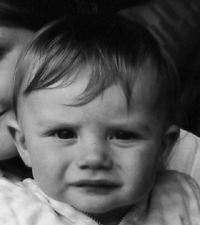In the early hours of Monday, the sun just beginning to fade away Orion, my sister Jenn and I bundled up and walked to the hospital for my PFO closure. “Procedure, not surgery,” said Sam Lau, my energetic cardiologist. Okay, procedure, but they were still going to fiddle with my heart. When I checked in, the first literature I received was about advance directives; the first line read “Many people today are concerned about the medical care they would be given if they should become terminally ill or unable to communicate their health care choices.” Well, I had been calm.
One gown, two grippy socks, one superb shaving job (I would have waxed if they’d told me), one Valium (unnecessary), six Plavix, and one aspirin later, I was wheeled into the expensive-looking procedure room, where all the women were wearing funny, puffy, brightly-colored chef-type bonnets. They gave me one when I admired theirs. I asked that they not give me too much sedative, since it put me to sleep for hours last time, and I really wanted to see and hear the procedure. No such luck. I was awake for the whole thing, but there was too much machinery obscuring my view and too many lead panels interfering with my ability to hear the cardiologists. From what I could gather, they were looking inside me via a chest x-ray (the piece of machinery I most wanted to punt) and, once it was in place, a catheter camera in my left atrium. I recommended that they put a screen on the ceiling for the patient to see the procedure.
Dr. Lau performed the procedure, assisted by Dr. Tom Jones, a cardiologist from the Children’s Hospital in Seattle. Dr. Jones had been invited down because he’s done hundreds of PFO closures in addition to closing some atrial septal defects (ASDs). Before they had a camera in my heart, they thought I might have an ASD, which is when there’s a wide-open hole between the heart’s atria, hence the addition of Dr. Jones to the team. More commonly what people have (maybe as many as 40% of people my age), and what I ended up having, is a PFO, or patent foramen ovale. There’s a flap of heart tissue like a door between my atria, and it allows some blood to pass from the right to the left atrium instead of proceeding normally from the right atrium to the right ventricle and to the lungs. That’s normal in the womb, because we don’t use our lungs, but it should close in a child’s first few years for most efficient heart use and less likelihood of stroke. My PFO was rather large, 11 mm, or about the width of the fingernail on my first finger; I don’t actually know how big other people’s usually are, but that seems big – I mean, I could have fit a kidney bean through there.
While I lay still, Dr. (“Please call me Sam”) Lau inserted catheters on either side of my groin into veins extending up to my heart. The left side had a four millimeter wide sheath holding open the vein for the camera, and the right had one three mm wide for the catheter with the closing device, an Amplatzer PFO occluder. He carefully but relatively quickly measured the width of the PFO and inserted the Amplatzer. I wish I could tell you more, but I missed it. Afterward, he left the sheaths in my veins but took out the catheters; my blood had to clot well before the sheaths would be removed, and they’d given me a huge dose of two anticoagulants that morning.
The sheath removal was definitely the worst part of my day. My nurse, Sue, said she’d have to use a “clamp” to put pressure on my vein to stop the bleeding. Do you remember ring stands from high school chemistry? They had wide, metal bases with poles to which one could attach various clamps to hold burets. Well, Sue had a ring stand with a screw-down pad attached to it. She put the base under my mattress and then screwed the clamp down just inside my hip bone to shut down the vein so she could remove the sheath. Well, I breathed deeply and slowly, trying to relax, and my blood pressure still dropped to 78/39 as they removed the first one. Sue decided to boost my blood pressure with some atropine and also to give me a little morphine for the second one. I may have had more drugs on Monday than I’ve had in the rest of my life combined.
Now, 72 hours later, I have a heart without a hole, big yellow bruises just inside my hip flexors, and some lightheadedness, a side effect of the anticoagulant Plavix, which I’ll be on for a few months. And I’m no more likely to have a stroke than any other 33-year-old, fit, non-smoking, whole-hearted woman.
I’ll keep you updated about PFOs in the general population. There’s currently some research about the correlation between migraines and PFOs; insurance companies may actually prefer to pay for closure rather than a lifetime of migraine medication. Also, PFOs may be genetic, so we’ll keep an eye on Sylvan’s heart.





